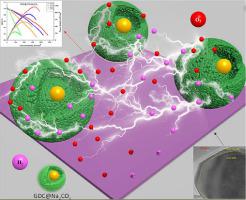Electrochimica Acta ( IF 6.6 ) Pub Date : 2022-11-23 , DOI: 10.1016/j.electacta.2022.141592 Muhammad Ali Kamran Yousaf Shah , Yuzheng Lu , Naveed Mushtaq , Sajid Rauf , Muhammad Yousaf , Bin Zhu

|
Lowering the operating temperature with enhanced performance and better efficiency is considered a universal R&D bottleneck for the progress of low-temperature (<520 °C) solid oxide fuel cells (SOFCs) or ceramic fuel cells (CFCs) to avail the opportunities of commercialization. Bulk doping is the primary ionic conduction mechanism in traditional electrolyte materials for CFC, mainly influenced by the operating temperature and bulk density, thus resulting in high operational temperature. Herein, we proposed a new mechanism for tunning Ce0.9Gd0.1O2-δ (GDC) electrolyte based on a nanocrystalline structure from surface or grain boundary conduction to interfacial conduction by introducing the carbonates to form the heterostructure, exhibiting an extremely high ionic conductivity of (0.2 S·cm−1) at 520 °C. At first, we noticed that the grain boundary conduction of GDC is causing to enhance the charge carrier leading to establishing surface conduction. We further modify the GDC with carbonates to form the core–shell heterostructure to boost ionic conduction. The constructed cell with core–shell heterostructure has exhibited a remarkable performance of 968 mW/cm2.
In contrast, 578 mW/cm2 was achieved from the surface conduction of GDC, and at the same time, we observed immensely low grain-boundary resistance from the impedance analysis. The mechanism of core–shell structure formation has been discussed in detail, and the ionic conduction at the surface and interfaces can be considered the dominant conduction mechanism for GDC electrolytes. This work has explored a new approach by tuning the ionic property from surface to interface to develop advanced CFCs, significantly improving the state-of-art GDC electrolyte via enhancing surface/interface conductions. This may be developed as a more functional approach for advanced energy materials, e.g., battery and electrolysis devices.
中文翻译:

先进的低温 400–500 °C 燃料电池使用钆掺杂二氧化铈电解质的表面和界面传导
降低工作温度以提高性能和提高效率被认为是低温(<520°C)固体氧化物燃料电池(SOFC)或陶瓷燃料电池(CFC)取得商业化机会的普遍研发瓶颈。体掺杂是传统CFC电解质材料的主要离子传导机制,主要受工作温度和体积密度的影响,从而导致工作温度高。在此,我们提出了一种新的调谐 Ce 0.9 Gd 0.1 O 2-δ的机制(GDC) 基于纳米晶结构的电解质,通过引入碳酸盐形成异质结构,从表面或晶界传导到界面传导,在 520 °C 时表现出 (0.2 S·cm -1 ) 的极高离子电导率。首先,我们注意到 GDC 的晶界传导导致电荷载流子增强,从而建立表面传导。我们进一步用碳酸盐修饰 GDC 以形成核壳异质结构以促进离子传导。构建的具有核壳异质结构的电池表现出 968 mW/cm 2的卓越性能。
相比之下,GDC 的表面传导实现了 578 mW/cm 2,同时,我们从阻抗分析中观察到极低的晶界电阻。已经详细讨论了核壳结构形成的机制,表面和界面的离子传导可以被认为是 GDC 电解质的主要传导机制。这项工作探索了一种新方法,通过调整从表面到界面的离子特性来开发先进的 CFC,通过增强表面/界面传导显着改善最先进的 GDC 电解质。这可能会被开发为一种更实用的方法,用于先进的能源材料,例如电池和电解装置。



























 京公网安备 11010802027423号
京公网安备 11010802027423号